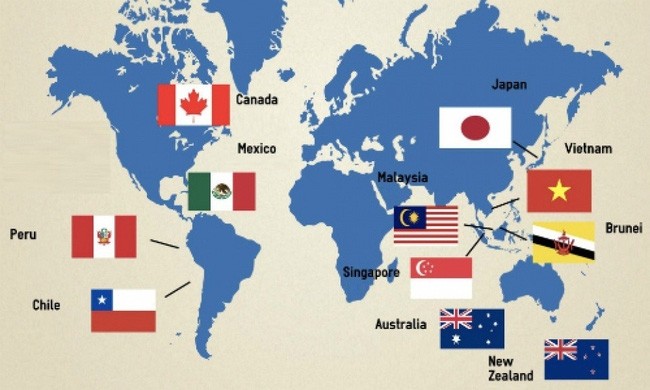The CPTPP is a version of the Trans-Pacific Partnership (TPP) without the United States, gathering the participation of 11 member countries, including Vietnam. Despite the lack of the US, a former TPP member, the CPTPP still creates a free trade area accounting for about one tenth of the world economy. According to calculations of economic experts, the pact will form one of the largest free trade areas globally, with a market of nearly 500 million people and a total GDP of approx. US$10.1 trillion, accounting for 13.5% of the world’s GDP.
The content of the CPTPP is almost unchanged from the TPP, although the 22 suspended provisions are mainly related to intellectual property, aiming to ensure a balance between the 11 member states. Accordingly, the CPTPP will help reduce taxes for agricultural and industrial products, loosen regulations on investment and strengthen protection of intellectual property rights. Therefore, it is strongly hoped by the CPTPP members that the deal will help countries in the region to break down the “grip” of protectionism, while becoming a motivation stimulating economic growth, creating more jobs, reducing poverty and improving the quality of life of people in member countries.
Australia, Canada, Japan, Mexico, New Zealand and Singapore were the first six countries to ratify the CPTPP, paving the way for the agreement to come into effect. The pact will take effect in Vietnam from January 2019. As soon as the CPTPP provisions are officially operating, a number of member states can immediately “pick sweet fruits” in the field of trade.
Reuters has quoted New Zealand’s Minister for Trade and Export Growth David Parker as saying that three CPTPP member countries, namely Japan, Canada and Mexico, have immediately reduced tariffs. Vietnam will also cut taxes in the first month of next year, and the same move will be taken by the remaining member countries. Leaders in the CPTPP nations have voiced their belief that the agreement will bring a “boost” to their countries’ economic growth. Parker affirmed the CPTPP promises to “deliver an estimated US$222 million of tariff savings to New Zealand exporters annually once it is fully in force”, with almost half of that - or US$105 million - available in the first 12 months. For example, New Zealand’s fisheries products, which face tariffs of 20% into Mexico for some lines, and tariffs of up to 10% in Japan, now have a higher competitive opportunity in the two markets, as the CPTPP will see all tariffs eliminated on fisheries exports. For Australia, experts estimate the deal will help businesses grow strongly and contribute US$11.1 billion to the Australian economy each year by 2030. Meanwhile, in Canada, industrial and agricultural producers are expected to achieve “big wins” when the CPTPP is implemented. Economic experts predict that the CPTPP will enable its Southeast Asian member nations to grow by more than 2% of their GDP by 2030. The economy of New Zealand, Japan, Canada, Mexico, Chile and Australia will also increase by 1% of GDP thanks to the CPTPP. Particularly for Vietnam, it is said that the CPTPP opens up great opportunities for the country to connect with big economies. This agreement can help Vietnam’s GDP and exports increase by 1.32% and 4.04% by 2035, respectively. The total import turnover may increase by 3.8%, lower than the rate of export growth. So, the overall impact on the trade balance is favourable.
In addition to its positive impacts on economic growth, analysts also appreciate the role of the CPTPP in fighting trade protectionism, especially in the context of the US-China trade war being at risk of spreading widely. The World Trade Organisation (WTO) recently released a report showing trade restriction measures are on the rise. Accordingly, in the past year or more, WTO member countries have imposed 11 new trade restriction measures each month, higher than the figure for the period of 2016-2017, at nine. The increasing trade barriers are hindering global economic growth. WTO Director-General Roberto Azevedo has warned of the serious consequences of tariff-response measures among the world’s leading economies, which are yet to be seen, but will happen in the future and will harm the global economy.
In the aforementioned context, the CPTPP officially coming into effect, and lowering taxes and trade barriers, is seen as a driver of growth as well as a “bright spot” of the global economy, because it helps countries maintain the spirit of free trade. This is the reason why Japanese Economy Minister Toshimitsu Motegi recently affirmed that the CPTPP is “the answer to the problem of globally escalating trade protectionism”.
















